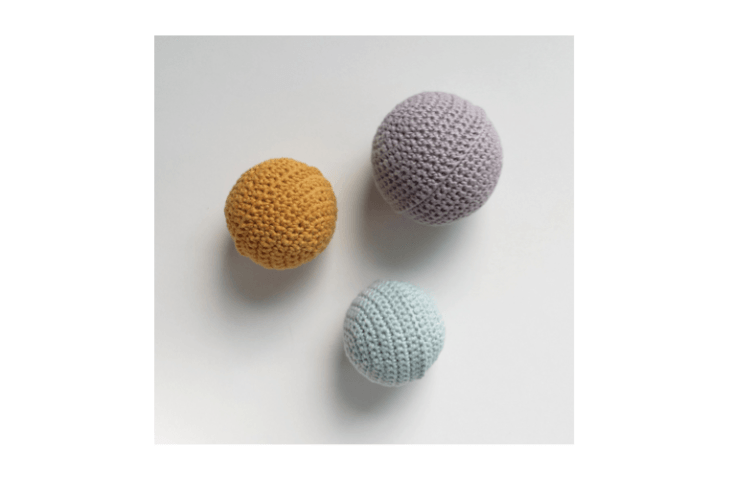
With the latest research touting the benefits of play, it’s natural for parents to want to gear up on every gizmo and gadget that promises to jump-start baby’s development. But too many toys can actually overwhelm her (not to mention your budget). Minimalist parents looking to maximize their infant’s physical and cognitive development with just a few simple toys should look for the following qualities:
- Simple designs and basic shapes that are easy to grasp and will engage your child’s growing imagination.
- Multipurpose toys, such as a rattle that also serves as a teether.
- Toys that grow with your child, such as blocks that can be used in increasingly complex creations.
- Natural materials that are better for the environment and heirloom quality construction that’s built to last.
Here is our minimalist guide of the top toys that will enrich baby’s first months.
Featured image by Matthew Williams from Living Large in 675 Square Feet, Brooklyn Edition.
1. Baby Gym/Mobile

The minimalist parent can rest assured if they choose to forgo bouncers and swings, because floor-play, which simultaneously engages both the body and mind, is far more essential to baby’s physical and cognitive development. Any old blanket with a few choice rattles and blocks will do for “tummy-time,” but a mobile or play gym is ideal for times when baby’s flipped over. Relatively simple in design, they need not be fancy or bright. A simple wooden arch with a few hanging toys is enough. Etsy is an excellent source for minimalist wooden play gyms, such as these folding versions from Lana Crocheting; from $81.95. You can even make your own.
Mobiles, especially those hanging over the changing table or crib, are also beloved by baby. Again, with a few sticks and strings, it’s easy to make your own.
2. Rattle/Teether

Babies love to explore their world, not just with their eyes, but equally with their hands, ears, and mouths. A good rattle should engage many senses at once. Easily portable, they are an essential component of baby’s development arsenal.
3. Balls

One of the oldest toys in existence, balls will see your child from infancy to adulthood. Infants will reach for them during floor play, while babies who can sit up and crawl will enjoy tossing, rolling, and chasing them.
4. Nesting Cups or Boxes

Among the most versatile of toys, nesting cups or boxes help baby with sorting shapes and colors. Flip them over, and baby becomes a mini engineer, building tall towers. Later, cups and boxes can be used in imaginative play as bowls or pots, nests or beds, doll houses, and parking garages. If they’re plastic, you can also use them in the bath.
5. Small Wheels

Let’s face it, vehicles are impressive inventions, and it won’t take baby long to fall under the spell of these awesome and ubiquitous machines. At this stage in baby’s development, parents should choose smaller vehicles that fit comfortably in their child’s hand. Bells and whistles and moving parts are for a bit later.
6. Cloth or Board Book

It’s never too early to introduce books to your baby. Even if they can’t yet hold their head up, your infant will relish cuddling in your arms and listening to the rhythmic sound of your voice as you read. Once they can sit, babies enjoy turning the pages themselves and gazing at the pictures. At this stage, parents should choose sturdy cloth or board books with simple graphics. Interactive sensory books that squeak, have different textures that baby can feel, or flaps they can lift are a great choice.
7. Basic Blocks

A toy that grows with your child, basic blocks are musts for any toy collection. At first a few colorful cubes spread out during tummy time will entice baby to lift his head and reach out his fingers. Later the little future architects will enjoy arranging and stacking them. Depending on their design, these multi-faceted toys can also be used to teach colors, letters, and numbers. Some even have puzzles on one side. For babies, make sure their first block set includes cubes that fit comfortably in their small hands.
8. Cuddly Friend

Babies as young as 6 months old may already have developed an attachment to a special friend that goes with them everywhere. (Here’s a tip from a seasoned parent: If this happens, take off your minimalist hat for a second and go out and buy an exact replica right away!) This is a natural part of baby’s development as a social animal. Again simple, soft animals or dolls are best for this age group. Make sure they are not too large for baby and that they have no small parts that baby could choke on.
9. Block Puzzle

Older babies will start to enjoy the spatial problem-solving that puzzles offer. Choose sturdy puzzles with chunky pieces and basic shapes that are easy to grasp.
10. Bath Toys

Babies don’t need much in the bath; some cups, a boat, and a rubber duck will do. Bacteria and mold can be a problem, so choose products with no holes, and always dry everything thoroughly.
Honorable mentions:
- Early art supplies: As soon as they can sit, babies may enjoy the tactile sensation and colorful results of Eco-friendly Finger Paints; $16.
- Mirrors: Infants love faces, particularly their own. Safe acrylic mirrors can be mounted on the wall of the nursery or playroom.
- Teethers: Happily for me, my children were able to get through teething by noshing cloth animals, rattles, and other toys they already had. But for infants who experience a lot of pain, a specialized teether such as Hevea’s Natural Rubber Panda Teether is recommended; $14.
N.B.: This post is an update; it was first published on February 1, 2018.
For more child-friendly design ideas, check out these stories:






Have a Question or Comment About This Post?